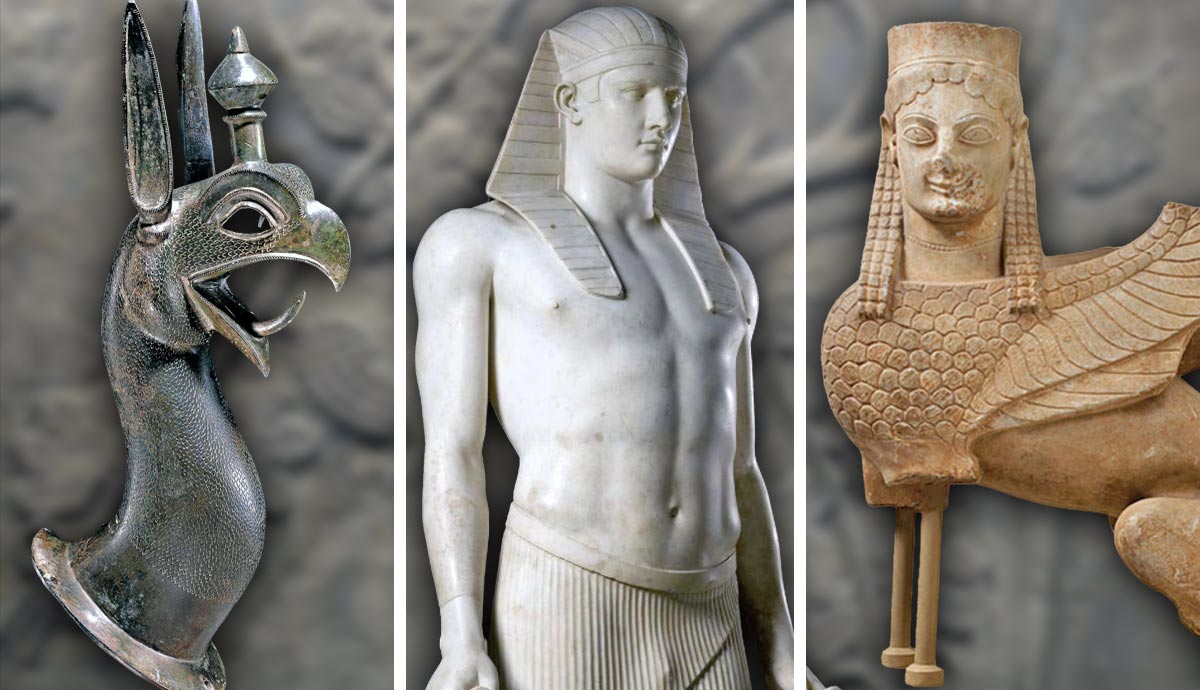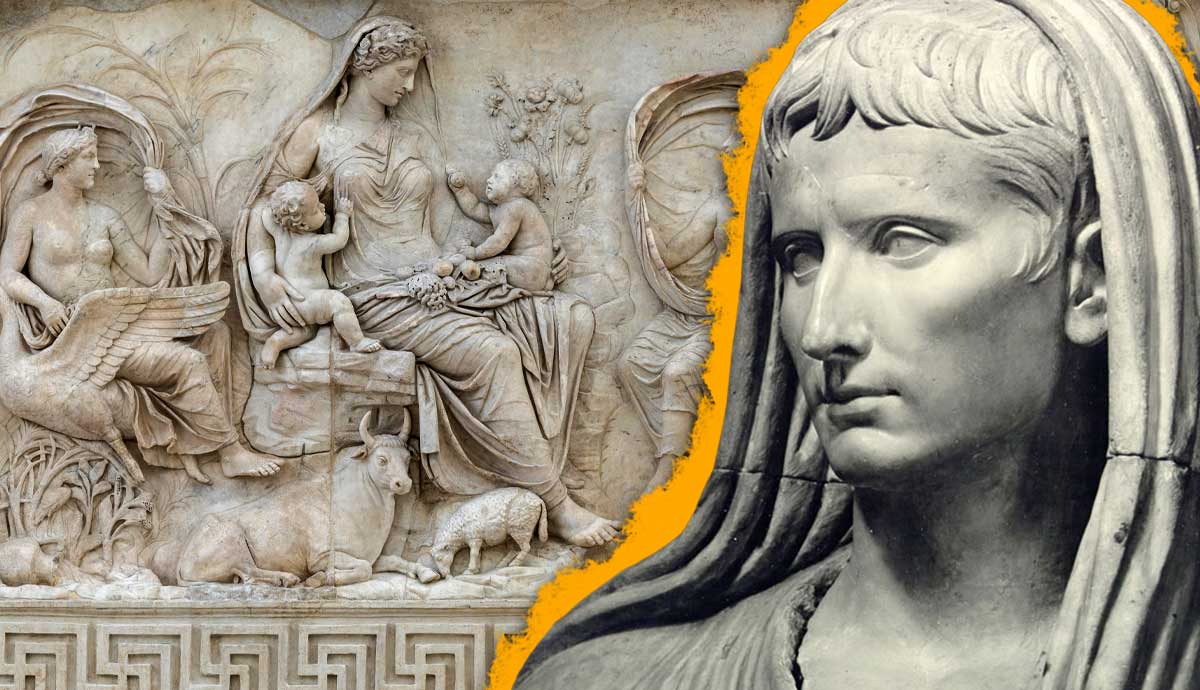
summary
- The Greeks copied Near Eastern motifs, such as exotic animals and fantastic beasts.
- They also borrowed production methods, such as the lost wax technique for monumental sculpture, and the famous Greek Kouros were influenced by Egyptian statuary.
- Hellenization from the 4th century BCE onwards saw Greek art influencing the Near East, though some trends, such as Roman verism, may still have had Near Eastern origins.
Ancient Greek art occupies a central space in many museums around the world. Whether it is geometric vases, beautiful sculpture, or fine jewelry, Classical Greek art is some of the most prized art from the ancient world. The Romans were so impressed with Greek art, especially sculpture, that they replicated the style and, in some cases, even made direct copies of Greek masterpieces. But long before Greek artists inspired Roman art, the Greeks themselves were being influenced by artistic traditions from ancient Egypt, Mesopotamia, and the Levant.
Early Greek-Near Eastern Cultural Exchange & Influence

Near Eastern artistic influences were not forced on the Greeks, nor did they happen suddenly. They were the result of centuries of cultural exchange. The cultural ancestors of the Classical Greeks, the Minoans and Mycenaeans, developed extensive trade and diplomatic contacts with several Bronze Age Near Eastern cultures. When the Bronze Age system collapsed around the year 1200 BCE, the contacts between the Aegean and the Near East diminished, but did not totally disappear.

When the Greek-speaking world emerged from its “dark age” and Classical Greek culture was born in the 8th century BCE, extensive contact with the Near East was reestablished as the Phoenicians established new trade routes across the region. From the 8th century BCE, eastern gods flooded the Greek world, which led to a revolution in art. Metalware, ivory carvings, trinkets, and probably textiles were imported into Greece and stimulated artistic expression.

The early Near Eastern influence on Greek art primarily originated in three locations: Phoenicia, Syria, and Urartu. Uratu provided early metalworking influence, while central Syrian artisans shared their ivory working expertise. Sculptures from northern Syrian cities provided the Greeks with early templates. The Phoenician “composite style,” which blended elements from throughout the Near East, was another important influence evident in Classical Greek art. Near Eastern artistic objects have been found at Greek sanctuaries, deposited as votive offerings to the gods, suggesting that Near Eastern art was widely valued.
Near Eastern Motifs & Iconography in Greek Art

One of the clearest signs of Near Eastern influence in Greek art is the replication of Near Eastern motifs in Greek art. Mythical creatures with Near Eastern origins became popular in Greek art in the 7th century BCE. Tripods, amphorae, bowls, and other devices and utensils were commonly adorned with griffins, sirens, and sphinxes, among other creatures. Although many of these creatures later made their way into Classical Greek literature, they can also be seen in the much earlier art of Mesopotamia, Egypt, and the Levant. This borrowing of motifs in a style more familiar in the Near East is often called “Orientalising.”

Real animals that had spiritual significance in earlier Near Eastern societies also made their way into Greek art. The Greeks had a particular fondness for lions, although the ferocious feline was only native to the Macedonian region of the Greek-speaking world. The Greeks not only adopted the animals from the Near East, but also their poses and presentations. Depictions of animals went on to become very common in Greek art, especially on pottery.

Early Greek artists also adopted artistic techniques from the Near East. In addition to the techniques mentioned earlier that the Greeks borrowed in the 8th century BCE, they also learned the “lost wax” method of bronze statue production from Egypt. This process involved making a sculpture in wax over a clay core that was then covered in bronze. These bronzes were extremely popular in Greece, and more Near Eastern bronzes have been found during archaeological excavations in Greece than in the Near East itself. This method was used for the first life-sized Greek statues in the late 6th and early 5th centuries BCE.
Egyptian Sculpture and Classical Sculpture

Greek sculpture emerged out of the dark age in the 8th century BCE with little precedent or influence from the earlier Aegean cultures. The pre-classical cultures of the Minoans and Mycenaeans focused their artistic energies on frescoes and architecture, so the Greeks had to look east. As the Greeks entered what modern scholars have termed the “Archaic Period” (c. 800-480 BCE), they began building temples. A primary feature of these early temples was cult statues, which were believed to be the earthly avatar of a particular deity. The Sanctuary of Hera (the Heraion) on the island of Samos is one of the most interesting archaeological sites of the Archaic period for art historical reasons.

Several objects of Near Eastern origin were discovered at the Heraion, the most important of which was a bronze statue of the Egyptian goddess Mut. This object likely provided the template for Greek artists to create a statuette of the goddess Hera that was also discovered in the temple. The Greek statue, though, has some noticeably different details. The fabric of Hera’s clothing is much more detailed and is overall less “fleshy” than its Egyptian counterpart.

The Egyptian-influenced statuettes gave way to a distinct sculptural form known as the kouros in the 6th century BCE. Kouros is the term for a male version of this type of statue, while kore is the term used for female figures. One of the earliest and best-known kouros statues is the “New York Kouros”, which is currently in the Metropolitan Museum of Art, New York. The New York Kouros and later kouroi (plural of kouros) statues followed the Egyptian sculptural canon of proportions, but a closer examination reveals some notable differences.
Greek artists did not employ the supporting pillar that was nearly universal in Egyptian statuary, and harder granite was usually the preferred medium. Greek kouroi are also notable for being nude, while Egyptian figures were always dressed in a kilt. However, Greek korai (female kore) were always clothed, usually with well-detailed dresses. Overall, Greek kouroi did not embody or symbolize power the way that Egyptian statues did. Perhaps this is because Greek kouroi were used in a variety of different settings that were not always sacred.

The Egyptians’ influence on Greek statuary can be traced back to the late 8th and early 7th centuries BCE, particularly during Egypt’s 25th and 26th dynasties (744-525 BCE). It was after the Nubians conquered Egypt and established the 25th dynasty that a form of “realism” that combined elements of “idealism” entered Egyptian art. Egyptian artists employed sculptural techniques of the early periods and added new elements that gave each figure a degree of individuality. They also added a characteristic “smile” to their sculptures that, along with the canon of proportions, was adopted by Greek artists. This combination of idealism and individuality would be the first steps toward true portraiture that was later achieved by Greek artists.
Hellenism & Beyond

By the late 4th century BCE, the Hellenic world and the Near East had become intertwined in many ways, and artistic influences had come full circle. The Achaemenid Persian Empire (550-330 BCE) was eclectic in many ways, especially in terms of art and architecture. Achaemenid Persian sculpture was influenced by Egypt and Mesopotamian precedents, but it also clearly borrowed from its Greek rivals to the west. The Achaemenid style did not last very long, as it was replaced by Hellenism.

When Alexander the Great (ruled 336-323 BCE) conquered the Achaemenid Empire, he initiated the era of Hellenism, when Greek culture spread throughout the Near East. Greek artistic styles impressed themselves on the older cultures of the Near East, but another round of Near Eastern influences manifested in Hellenistic art. Hellenistic art was grand, ostentatious, and some would say pretentious. Artists used Near Eastern techniques with Greek forms, while Near Eastern subject matters and forms were often Hellenised. This blending of artistic styles was most apparent in Egypt.

The blending of Egyptian and Greek styles became so ubiquitous in Egypt that today it is difficult to differentiate sculpture of the 30th dynasty from the Ptolemaic period. Eventually, Egyptian sculpture acquired a more Hellenistic style with only superficial Egyptian features. This superficial “Egyptianness” is exemplified by the stone head of a Ptolemaic king from the Yale Peabody Museum. Smith noted that the “Egyptian headdress grafted onto the imperial portrait does not disguise the Greek curls escaping underneath.” It is believed to be either Ptolemy VIII (ruled 170-163 BCE and 145-116 BCE) or Ptolemy X (ruled 107-88 BCE). The superficial use of Egyptian accoutrements on Hellenistic sculpture was adopted by the Romans, who then developed their own form of sculptural realism.
Egyptian Influences on Roman Verism

Artists often employed the superficial use of Egyptian features and accoutrements on statuary that was otherwise Hellenistic in style. Perhaps one of the best-known examples of this is the statue of Osiris-Antinous now in the Vatican Museum. Antinous was a friend of the Emperor Hadrian (ruled 117-138 CE) who drowned in the Nile River. The emperor deified Antinous and syncretized him with Osiris, the Egyptian god of the dead. The statue of Antinous-Osiris is clearly Hellenistic in style, with the Egyptian nemes headdress almost being an afterthought.

Art historians often point to Roman Republican sculpture portraiture as the natural extension of Classical Greek and Hellenistic portraiture. Although this is certainly true to a great extent, it diminishes the innovation of Roman sculpture as well as the influence of Egyptian style. The sculptural realism that Egyptian artists began employing in the late 8th century BCE found a home in the realism of late Republican sculpture, often termed “verism.” Notable art historians, such as Bernard Bothmer, argue that the verism seen in sagacious middle-aged Roman senators can be traced directly back to the sculptures of the Nubian and Saite kings of Egypt’s 25th and 26th dynasties.

The validity of this argument is questioned by other scholars, who point out that there was limited contact between Egypt and Rome in the Republic when verism became popular. They suggest that this was rather a Greek response to growing Roman domination. Talented Greek artists, rather than create idyllic portraits of their Roman oppressors, focused on bringing out their flaws in a kind of caricature. But this theory is also questioned, as why would the Romans have perpetuated what they knew was an insult? Suffice to say that the artistic influence between cultures is incredibly difficult to unpick centuries after the fact.










